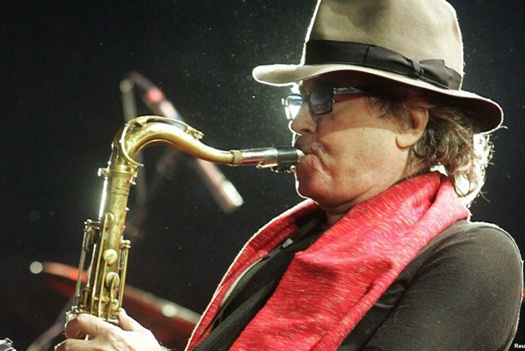Regardless of his subsequent and future transgressions, Gato Barbieri deserves a lifetime’s worth of slack for his work between 1965 and ’75.
The Argentine tenor saxophonist’s legacy from that decade is significant: fruitful associations with Don Cherry, Charlie Haden’s original Liberation Music Orchestra, and Dollar Brand; his Flying Dutchman discs (particularly The Third World); the soundtrack for Last Tango In Paris; and the Impulse! dates, from which the two-disc Latino America is compiled. Originally issued as the LPs Chapter One and Chapter Two, this body of work is arguably Barbieri’s greatest achievement (a case can be made for Tango, one of the most memorable film scores of all time), as it sensitized U.S. jazz fans to South American music and culture in an unprecedented manner, and contributed significantly to both the globalization of jazz and the articulation of world music.
Most of the material features a 12-piece ensemble Barbieri assembled in Buenos Aires in ’73 that included several musicians playing such indigenous instruments as the quena (a wooden flute), the arpa India (a simple harp), the charango (a ten-string ukulele-sized instrument), bombo Indio (a set of ten tom toms) and various percussion instruments. The contrast between the indigenous instruments and the contingent of trap drums and electric guitars and basses provided a bracing backdrop for Barbieri’s full-throttle delivery of his propulsive motivic themes. The ensemble’s unflagging rhythmic vibrancy sustained a feverish pulse on such extended workouts as “Encuentros” and “La China…,” while its exotic timbres underscored the smoldering heat of Barbieri’s romanticism on such lyrical pieces as “India.”
Barbieri also successfully mixed modern and traditional instruments in subsequent sessions in Rio de Janeiro, which featured a cavaco (a small four-string guitar) and a full arsenal of percussion (quica, agogo, etc.). While the Rio sessions are engaging, the underlying rhythmic urgency of the first Buenos Aires tracks is replaced by a more relaxed samba-infused groove. The sequencing of the set’s second disc, which alternates between the Rio tracks and those made by the Buenos Aires ensemble made in Los Angeles late in ’73, provides some telling comparisons; even when he starts out relatively mellow, as on “Para Nosotros,” it isn’t long before Barbieri is screaming full-bore against a cascade of rhythms.
Still, not everything Barbieri recorded with Buenos Aires musicians had such by-the-throat intensity. “Nunca Mas,” a lovely mid-tempo tune with a relatively conventionally configured tango band of piano, bandoneon and bass, featuring Dino Saluzzi, is the epitome of Argentine sophistication. Originally, Barbieri had intended to record solely with this type of ensemble, but due to one of the many plot twists chronicled by producer Ed Michel in his stranger-than-fiction booklet essay, Barbieri went to a Plan B which proved to be history-making.
01. Introducción: Canción del Llamero (En Vivo)
02. Viva Emiliano Zapata (En Vivo)
03. La China Leoncia Arreó la Correntinada, Trajo Entre la Muchachada, la Flor de la Juventud (En Vivo)
04. Cuando Vuelva A Tu Lado (En Vivo)
05. Medley: Intro / She Is Michelle / Latinoamérica / El Arriero (En Vivo)
06. El Último Tango en París (En Vivo)
Gato Barbieri Saxo tenor
Edy Martínez Piano y sintetizadores
Guillermo Franco Percusión
Robbie González Batería
Nilson Matta Bajo eléctrico







More Stories
CD review: George Benson – Dreams Do Come True: When George Benson Meets Robert Farnon – 2024: Video, CD cover
The band was tight as ever. The Warren Haynes Band cuts loose: Video, Photos
Interview with Alvin Queen: Feeling Good – I heard these tunes played by … Video, new CD cover, Photos